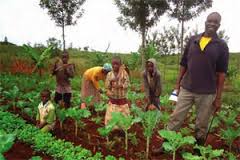Checking Out the Differences In Between Commercial Farming and Subsistence Farming Practices
The dichotomy between business and subsistence farming methods is marked by varying goals, operational scales, and source use, each with profound implications for both the environment and culture. Alternatively, subsistence farming highlights self-sufficiency, leveraging traditional approaches to maintain family needs while nurturing area bonds and cultural heritage.
Economic Objectives
Financial objectives in farming methods usually determine the methods and scale of operations. In commercial farming, the main economic objective is to make best use of profit.
On the other hand, subsistence farming is primarily oriented in the direction of fulfilling the prompt demands of the farmer's household, with surplus manufacturing being minimal. The economic objective here is frequently not benefit maximization, however instead self-sufficiency and danger reduction. These farmers normally run with minimal sources and depend on typical farming strategies, customized to neighborhood ecological problems. The main objective is to make sure food protection for the house, with any kind of excess fruit and vegetables sold locally to cover basic necessities. While business farming is profit-driven, subsistence farming is focused around sustainability and strength, mirroring a basically various collection of financial imperatives.

Scale of Operations
The difference in between commercial and subsistence farming ends up being specifically apparent when considering the scale of procedures. The range of commercial farming enables for economic climates of range, resulting in reduced expenses per device with mass manufacturing, increased effectiveness, and the capacity to invest in technological improvements.
In plain contrast, subsistence farming is generally small-scale, concentrating on generating simply enough food to meet the prompt demands of the farmer's household or regional community. The land area entailed in subsistence farming is usually minimal, with less access to modern innovation or automation.
Resource Utilization
Source use in farming methods exposes significant distinctions in between industrial and subsistence strategies. Business farming, defined by large-scale procedures, typically employs advanced modern technologies and automation to enhance the use of sources such as land, water, and fertilizers. These techniques enable for enhanced performance and greater efficiency. The focus gets on maximizing outcomes by leveraging economic climates of range and releasing resources purposefully to make sure consistent supply and profitability. Accuracy agriculture is increasingly taken on in business farming, utilizing information analytics and satellite innovation to keep an eye on crop wellness and enhance resource application, more boosting yield and source effectiveness.
In contrast, subsistence farming operates on a much smaller sized range, largely to satisfy the immediate needs of the farmer's house. Resource usage in subsistence farming is frequently limited by economic restrictions and a reliance on typical methods.
Environmental Influence

Alternatively, subsistence farming, exercised on a smaller range, generally employs traditional techniques that are much read more in harmony with the surrounding atmosphere. While subsistence farming normally has a reduced ecological impact, it is not without difficulties.
Social and Cultural Ramifications
Farming methods are deeply linked with the social and cultural fabric of communities, influencing and reflecting their worths, practices, and financial frameworks. In subsistence farming, the focus gets on growing sufficient food to satisfy the prompt demands of the farmer's family members, often fostering a strong sense of neighborhood and shared obligation. Such methods are deeply rooted in regional customs, with expertise gave via generations, find out this here therefore protecting social heritage and enhancing public connections.
On the other hand, business farming is largely driven by market needs and productivity, frequently leading to a change towards monocultures and massive operations. This strategy can lead to the disintegration of typical farming methods and cultural identifications, as regional customizeds and expertise are supplanted by standard, industrial approaches. The focus on efficiency and revenue can occasionally decrease the social communication found in subsistence neighborhoods, as financial transactions replace community-based exchanges.
The duality between these farming methods highlights the more comprehensive social ramifications of farming selections. While subsistence farming supports cultural connection and area interdependence, industrial farming straightens with globalization and economic growth, usually at the cost of standard social frameworks and cultural diversity. commercial farming vs subsistence farming. Balancing these elements continues to be a vital obstacle for lasting agricultural development
Final Thought
The exam of commercial and subsistence farming methods exposes substantial distinctions in objectives, scale, resource use, ecological influence, and social effects. Commercial farming prioritizes profit and effectiveness with large procedures and progressed modern technologies, frequently at the expense of ecological sustainability. Alternatively, subsistence farming emphasizes self-sufficiency, using conventional techniques and regional resources, thereby promoting cultural preservation and community cohesion. These contrasting approaches underscore the complex interplay in between financial development and the need for socially comprehensive and eco lasting farming techniques.
The dichotomy in between industrial and subsistence farming methods is noted by varying goals, operational reference ranges, and source usage, each with extensive effects for both the atmosphere and society. While commercial farming is profit-driven, subsistence farming is focused around sustainability and durability, reflecting a fundamentally various collection of economic imperatives.
The difference between commercial and subsistence farming comes to be especially apparent when considering the range of operations. While subsistence farming sustains social connection and community connection, commercial farming lines up with globalization and financial growth, frequently at the price of conventional social structures and cultural variety.The evaluation of commercial and subsistence farming methods reveals substantial differences in goals, range, resource usage, ecological effect, and social effects.